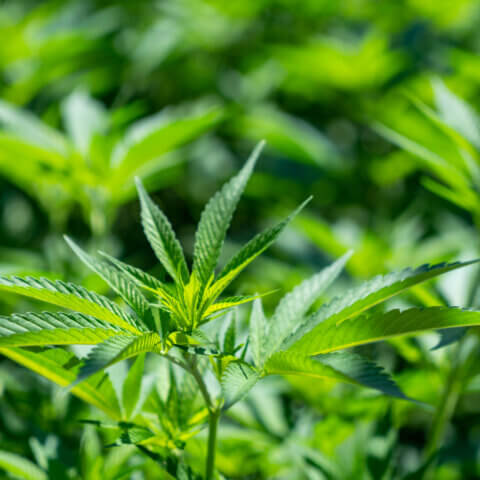-

FAQs About Hydroponics Nutrients
You’ve probably got questions about nutrients for growing your plants. We’ve got plenty of answers.
Explore -
Nutrient EC (milliSiemens/cm) TDS meter (NaCl standard) 3:2:1 2.3-2.5 1350-1450 2:2:2 2.2-2.4 1300-1400 1:2:3 2.1-2.3 1250-1350 - TDS, EC, PPM, etc
Conductivity is a measure of the strength of the nutrient solution. The higher the conductivity, the more dissolved solids there are in the solution. Delicate plants, cuttings, and seedlings can experience fertilizer burn if the conductivity is too high. Once the plants begin growing, they need a stronger nutrient solution, so conductivity must be increased by adding concentrated nutrient. Some plants prefer a milder nutrient strength, while others grow better and produce better quality fruit with a higher concentration.
- TDS, EC, PPM, etc
Conductivity is really a measure of the nutrients in the solution. Low conductivity implies a low nutrient concentration, which usually results in nutritional deficiencies and slow growth rates of your plants. One can look at the situation, as a higher conductivity is more food for your plants. However, be careful of very high levels as this can burn and or kill the plant.
- TDS, EC, PPM, etc
Ventilation is often overlooked as a problem. Plants absorb nutrients when the water molecules in the leaves respire (i.e. evaporate). Better ventilation aids a high transpiration rate, which translates into a greater rate of nutrient uptake. Remember that ventilation means changing the air, not just blowing it around the room (circulation).
- Water
Chlorine is highly volatile; it evaporates as soon as it hits the air. By the time the nutrient solution reaches the roots, the chlorine is gone.
- Water
In a properly functioning hydroponic unit, the roots receive oxygen from the air, which surrounds them, as well as from the oxygen, which is dissolved in the nutrient solution. The proper medium can play an important role in this process.
- Water
Temperature of the nutrient solution should be in the range of 65 to 80 degrees Fahrenheit (18 to 26 degrees Celsius). Before adding water to your reservoir, it is a good idea to allow it to come to the same temperature as the water in the reservoir. Plants do not like rapid temperature changes, especially in the root zone. Aquarium heaters can be used to warm the nutrient solution in the winter, and look for “chillers” to cool the solution in the summer if high temperature becomes a problem.
- TDS, EC, PPM, etc
Standard reference solutions are used. The bottles are marked with the conductivity (EC) value in milliSiemens/cm and the corresponding ppm values for sodium chloride (NaCl) and potassium chloride (KCl) solutions, and sometimes for a “442” reference mixture. The conductivity of sodium chloride solutions is close to that of hydroponic mineral nutrients, so a “1000-ppm NaCl” standard is most frequently used when calibrating the meter for hydroponic solutions. You should follow the calibration instructions in the manual, which the manufacturer of your meter provided.
- TDS, EC, PPM, etc
The electrical conductivity (EC) of your nutrient results from motion of mineral ions when the meter applies an electrical voltage. The ppM value of a sodium chloride solution happens to be very close to half of its conductivity value (in milliSiemens/cm), so many meters display the conductivity as an equivalent NaCl amount
- TDS, EC, PPM, etc
It is a common unit for measuring the concentration of elements in the nutrient solution. One ppm is one part by weight of the mineral in one million parts of solution.
- TDS, EC, PPM, etc
To obtain an approximate sodium chloride TDS value, multiply the EC reading (in milliSiemens/cm) by 1000 and divide by 2.
To get an EC value, multiply the ppm reading by 2 and divide by 1000.
Thus, if your EC is 1:
1 * 1000/2= 500 ppm.And if your ppm is 500:
500 * 2/1000= 1 EC - TDS, EC, PPM, etc
If you have plant nutrient recommendations in EC units, an EC meter is convenient. If your plant nutrient recommendations are in ppm values, a sodium chloride TDS calibration is easier to use.
- pH Dyanmics
Start out with one milliliter per gallon. Wait 15 To 30 minutes, and test your water again. Frequently you will only need 1 to 2 ml of pH Up/Down per gallon of water. You may need additional pH Up/Down if you have hard water. FloraSeries® is pH buffered to facilitate keeping the pH in a favorable range.
- pH Dyanmics
The easiest way is to continue adding pH Up. This is generally fine because the additional elements that are added are potassium ions. Potassium is frequently the highest element in hydroponic nutrient solutions. Sometimes pH crashes because of the presence of a large amount of microbial activity in the nutrient solution. This is usually a result of poor maintenance of the system due to infrequent nutrient changes or other stresses. The best way to avoid this scenario is to keep a clean system with adequate nutrition.
- Growing Media
Expanded clay pebbles are used in hydroponics as a medium to support the plant. They are chemically inert, do not affect pH and provide excellent drainage. They are made from a special type of clay, which is heated to a high temperature causing it to pop like popcorn.
- Growing Media
Coco peat, such as CocoTek Premium Coir, is an organic medium made from coconuts, frequently used in both hydroponics and seed sowing mixes. Its advantages are that it is lightweight, relatively inert and comes from a sustainable source. However, coco peat comes in various grades, and can actually be detrimental to plant growth if it contains salt-water residues from poor processing.
- Growing Media
Rockwool is a substrate made by melting rock, extruding it in threads and then pressing it into sponge-like blocks.
- Growing Media
Both expanded clay pebbles and coco peat are pH neutral media. Expanded clay pebbles provide free drainage and aeration, while coco peat provides moisture retention and the ability to hold onto a small amount of nutrients.
- Growing Media
They can. Rinse the growing media (especially important when using rockwool) before using it. We suggest you check the nutrient solution pH and ppm(see above) and adjust the solution accordingly.
- Water
Water containing too much calcium and magnesium (called “total Hardness”) may create serious problems. Contact your municipal water supplier who can provide you with an analysis of your water supply. If you are using well water, many laboratories can provide you with an analysis if you send them a sample. If the dissolved salts in your water supply measure 200 ppm or more, we strongly recommend that you obtain a water analysis to determine calcium content. Excessive calcium is the main factor in determining if your water is hard. If an analysis of your water supply reveals that the Calcium content of your water supply is greater than 70 ppm (mg/liter) you should use Hardwater FloraMicro. Hardwater FloraMicro provides rapidly growing plants with a combination of chelated micro nutrients uniquely formulated for hardwater conditions. Other options are to collect rainwater, install a reverse osmosis filtration system, or use purified water. Do not use mineral or “spring” water, which can unbalance the nutrient solution, or even be toxic to plants.
- pH Dyanmics
pH is a measure of the hydronium ion H3O+. It is based on a logarithmic scale from 0 to 14. “Pure” water has a pH of 7.0. If the pH is less than 7, the solution is acid. If the pH is greater than 7 it is alkaline. Because the scale is logarithmic and not linear, a pH of 6 indicates ten times more H protons than a pH of 7, and a pH of 5 indicates 10 times more protons than a pH of 6.
- pH Dyanmics
The ideal pH range for most hydroponic crops is between 5.5 and 6.5.
- pH Dyanmics
pH is important because it affects availability and absorption of several of the 16 atomic elements needed for plant growth. Maximum absorption of these elements is found at pH readings 5.5 to 6.5. When pH falls below this range many of the macro elements (N, P, K) have less availability, and absorption of the micro nutrients can reach toxic levels.
